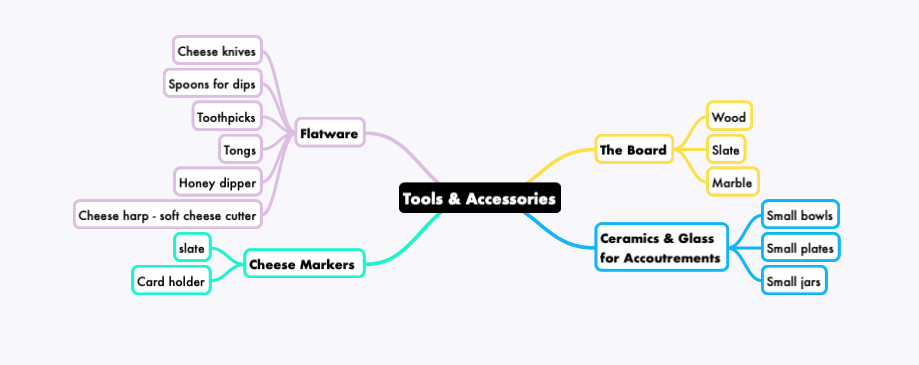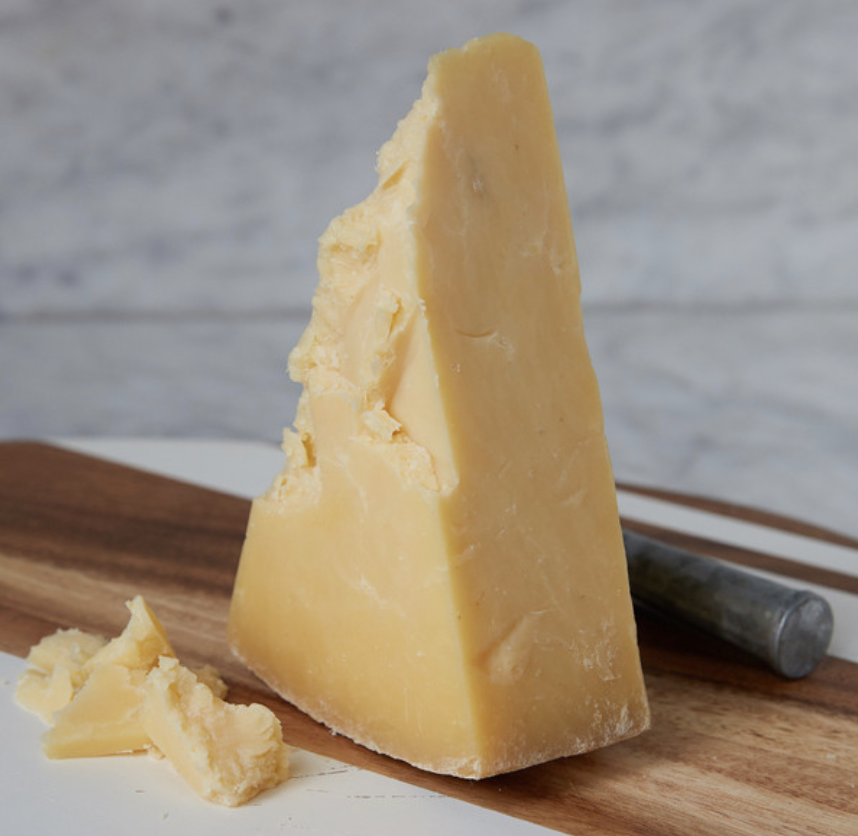The Art Of Charcuterie De-mystified
Charcuterie technically refers to cured meats, but its meaning has evolved over time. I like to think of charcuterie as the art of creating appetizers.
Charcuterie boards can be true showstopper, boasting award-winning cheeses, high-quality meats and delectable accompaniments. They can also be low-key by being a simple treat that you share with a friend or loved one while enjoying a Tuesday night lounge on the couch.
This is my guide to help you take that blank canvas of a board, and transform it into a mouthwatering masterpiece for any occasion.
But first a few tips!
Tip #1 Always include at least one or two familiar cheeses
cheddar and Havarti style cheeses are a great place to start
Once your guests drink a glass or two of vino and tuck in to these fan favorites they might be willing to be more adventerous
Tip #2 Work with odd numbers like 5,7,9
3 cheeses + 2 meats = 5
Tip #3 Figure out how much you need
For an appetizer, 3-4 ounces of charcuterie per person
If the board is the main food source, aim for 5-6 ounces of charcuterie per person
Tip #4 Make the food easy to access
Pre-cut/crumble cheese, have spoons for sauces/spreads, cut meat into easy to grab pieces, separate grapes into little single-serve clusters
Tip #5 Variety is the spice of life
Mix textures: along with hard & soft cheese, add crunchy, sweet, savory, salty, fatty, and acidic components
Consider working with cheese made from different milks: cow, sheep, goat, vegan
Tip #6 Add pizzaz
Fresh herbs, flowers and decorative fruit
Tip #7 Serve at room temperature to bring out all those bold flavors
let it sit for ~30 minutes prior to serving
Tip #8 Pair your beverages
If you want a “wide-spread” using two wines that will pair well with most things, I recommend Riesling (an aromatic white) + Pinot Noir (light-bodied red)
Tip #9 Check out my handy-dandy charts
Anatomy of a Charcuterie:
Is an inspiration that breaks down each catagory of ingredients. No need to pick from every category, use what fits best for the edible art you are creating
The wine list:
Breaks down each type of wine to help with cheese pairing
For example, cheddar goes best with full-bodied whites (like oaked chardonnay) and medium-bodied reds (like zinfandel)
The meat chart:
Briefly describes the 6 types of meat options that I recommend for a charcuterie
Tools & Accessories
Goes over the non-edible aspects of a charcuterie board. Places where you can find these items include:
Home Goods/TJ Maxx
World Market
Target
Walmart
Amazon
Thrift Stores
Antique stores
Anthropologie
Food52
Etsy
Tip #10 When to eat the rind
Some people love ‘em and some people hate ‘em. Although edible, the choice to eat is yours alone. Cheese rinds are meant to be eaten unless they are made of the following:
Wax
Cloth
Bark (but OK if you’re a termite)
Cheese
Cheddar
This cheese was first produced in Somerset, England using a specific process called “cheddaring.”
This is a versatile cheese that has a wide range of flavors.
Texture: Dense and/or crumbly
Milk Type: Typically cows milk, you may run into goat’s milk too
Flavor Profile: Tangy and salty - Buttermilk, buttered toast, caramel, beef boullion
Suggested brands:
Tillamook Medium Cheddar – more of a mild
Kerrygold Dubliner – medium
Cabot Extra Sharp or Farmhouse Reserve – sharp
Fancy Options:
Classic Food Pairing: pickles, mustard, apricot, fig, quince
Classic Drink Pairing: Full-bodied white wines, dry hard cider, medium bodied reds
Image source: https://www.murrayscheese.com/montgomerys-cheddar
Swiss
The term “swiss” is an umbrella term for firm, aged, pressed cow’s milk cheese. Also known as “Alpine” cheese. This cheese gets it’s hallmark holes from a bacteria called Propionic shermanii. These anerobic bacteria thrive in low-acid cheese like swiss. They produce CO2, which cause bubbles. Due to the unique elastic texture, the cheese can stretch around these gas bubbles instead of crack. Types of swiss cheese you may be familiar with include comet, Le Gruyère, Jarlsberg, and Annelies.
Texture: Firm and elastic
Milk type: Usually cow
Flavor Profile: Sweet and nutty – brown butter, toasted almond, white pepper, caramel
Suggested Brands:
Kaltbach Emmi Le Gruyère
Boar’s Head Blanc Grue Gruyère
Fancy Options:
Classic Food Pairings: Ham, mustard, rye, pickles, pickled onions, apple, honey, dark chocolate, pistachios
Classic Drink Pairings: Sparkling wine, light-bodied reds, medium-bodied reds, Saison, lambic and sour beers, Belgian ale
Image source: https://www.murrayscheese.com/jarlsberg
Parmesan-Type & Aged Gouda
Parmesan is an umbrella term derived from the name-protected term Parmigiano-Reggiano, which has aging, quality and standard of production requirements. In this section I am using it to describe hard, aged cheeses with robust flavor.
Texture: Hard, crumbly, dense
Milk type: Typically cow, sometimes goat
Flavor Profile: Sweet and nutty – buttered toast, candied nuts, butterscotch, balsamic vinegar, brine
Suggested Brands:
Boar’s Head Aged Gouda
Fancy Options:
Classic Food Pairings: Prosciutto, pears, apricots, quince, cherry, fig, marcona almonds
Classic Drink Pairings: light, medium and full-bodied red wine
Image source: https://www.murrayscheese.com/boerenkaas-gouda
Manchego & Sheepy
If you have yet to be acquainted with Spanish cheese, you’re in for a treat! Manchego is probably the mot well known variety. This firm cheese comes from the celebrated Manchega sheep who hail from La Mancha, a hot, dry region of Spain.
Texture: firm and smooth
Milk type: sheep
Flavor Profile: herbaceous, tangy, mac-n-cheese powder, macadamia nuts, butterscotch, fermented fruit, brine
Suggested Brand:
Boar’s Head Manchego
Fancy Options:
Classic Food Pairings: almonds, chorizo, walnuts olives, quince paste (membrillo), honey
Classic Drink Pairings: medium-bodied red wine, brown ale
Image source: https://www.murrayscheese.com/aged-manchego
Blue
This family of cheese Is known for its unique blue/green veining. This is due to the addition of Penicillium spores during cheesemaking. Oxygen is introduced into the spore-filled cheese by piercing the wheels, which allows the spores to develop. The spores breakdown proteins in the cheese that create it’s hallmark creaminess.
Texture: Varies – can be scoop-able, fudge-y or crumbly
Milk type: typically cow or sheep
Flavor Profile: Salty and funky – salty cream, tangy yogurt, unsweetened chocolate, smoky, black pepper
Suggested Brands:
BelGioioso Creamy Gorg or crumbly gorgonzola
Boar’s Head creamy blue cheese
Point Reyes Farmstead Cheese Blue Cheese, Original Blue
Fancy Options:
Classic Food Pairings: dark chocolate, pears, cucumber, carrots, candied nuts, honey
Classic Drink Pairings: aromatic white wines, dessert wines, dark stout beer
Image source: https://www.murrayscheese.com/roquefort
Brie & Creamy
Historically brie referred to mild northern French cow’s milk cheese that had a soft texture and edible “bloomy” white rind. This is another mold cheese who’s rind is flavored by Geotrichum candidum or Penicillium camemberti.
Texture: Soft, creamy
Milk type: Typically, cow but goat and blends are popular
Flavor Profile: cream, butter, yeast rolls, porcini mushroom
Suggested Brands:
La Bonne Vie Brie
Ile De France Brie bites
Boar’s Head French Brie
Fancy Options:
Classic Food Pairings: honey, cherry/dried cherry/cherry preserve, baguette, figs, grapes, chocolate, raw broccoli
Classic Drink Pairings: Sparkling wine, full-bodied and aromatic white wines, dessert wines, hard cider, sour ale
Image source: https://www.murrayscheese.com/st-stephen
Havarti-Style
Cheese in this family tends to be seen as humble everyday eating cheese. It usually comes in blocks without a rind or with a wax rind. Most countries have a version of this class of cheese: Denmark has Havarti. The Dutch have Young Gouda. Italy is home to Fontina and Asiago. America has Colby and Montaray Jack.
Texture: Semi-soft & pillowy
Milk Type: Cow
Flavor Profile: Buttermilk, Brine, Caramel, cooked mushrooms, Bitter Greens
Suggested Brands:
Cabot Pepper Jack or Monterey Jack
Roth Havarti Cheese
Boar’s Head Cream Havarti
Beemster Graskaas Gouda
Boar’s Head Fontina
Fancy Options:
Classic Food Pairings: Apples, pears, grapes, dried pears, tomato jam
Classic Drink Pairings: Full-bodied white wine, light and medium-bodied red wine, hard cider, wheat ale
Image source: https://www.murrayscheese.com/point-reyes-toma















